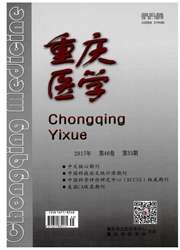

 中文摘要:
中文摘要:
目的:在骨组织工程中,如何制备出理想的支架材料一直是研究重点;目前主要的有天然生物支架材料、人工合成有机材料和无机材料等;生物衍生骨即天然生物支架材料的一种,由于其与天然骨在形态结构上较为相似,是近年来研究较多的支架材料之一;既往形态学研究局限于在二维层面,对于其三维结构参数分析较少。故本实验主要运用Micro-CT对生物衍生松质骨的三维结构参数进行分析,量化评价其作为骨组织工程支架材料的结构参数。方法:截取新鲜猪松质骨,经脱脂脱蛋白部分脱钙及去抗原处理后,制作成生物衍生骨支架;应用Micro.CT扫描,重建三维图并量化分析其结构参数,统计软件SPSS分析各参数间的相关性。结果:经Micro.CT扫描,得到二维CT图和三维重建图。各三维结构参数的值分别为:BV/TV(20.48±5.14)%;BS/BV(41.66±5.39)1/ram;Porosity(79.52±5.14)%;Tb.Th(0.10±0.01)mm;Tb.N(1.99±0.47)l/mm;Tb.Sp(0.32±0.05)mm;Tb.Pf(2.03±4.70)1/mm;SMI(1.28±0.35);DA(1.60±0.23);Corm.Dn(158.53±106.09)I/mm3。各参数间相关系数具有统计学意义的为:(1)Porosity与BS/BV、Tb.Th;(2)BV/TV与BS/BV、Tb.Th;(3)BS/BV与Coma.Dn、Porosity、BV/TV、;(4)Tb.Th与Porosity、BV厂IV、Conn.Dn;(5)DA与Corm.Dn;(6)Conn.Dn与Bs/BV、Tb.Th、DA。结论:Micro-CT扫描、量化分析是评价支架材料结构参数的理想方法;也证明生物衍生骨支架符合骨组织工程对支架材料的三维结构要求,尤其在孔径大小、孔隙率、表面积体积比等三维结构参数,此外,也可为其他支架材料的制备在三维结构上的要求提供参考依据。
 英文摘要:
英文摘要:
Objective: How to prepare the ideal scaffold has been a focal point in the bone tissue engineering. At present, the most used scaffolds are natural scaffolds, synthetic organic and inorganic scaffolds. The bio-derived cancellous bone scaffold is one of the natural scaffold materials. Because of its natural bone morphology, the bio-derived cancellous bone scaffold has been one of the research hotspots recently. Previous morphological study is limited to the two-dimensional level, and there are not too much research about the three-dimensional structure. So in the study, micro-CT was used to quantitatively analyze the three dimensional structure of bio-derived cancellous bone scaffolds, and to evaluate its structural parameters as bone tissue engineering scaffolds. Meflaods: The bio-derived bone scaffolds were obtained from fresh porcine cancellous bone after removing fat and protein. Micro-CT was used to scan and quantitatively analyze its structural parameters. The correlation coefficients were calculated by using SPSS statistical software. Results: The bio-derived bone scaffolds were obtained after derosination and deproteinization. 2D and 3D images were gotten through Micro-CT scan. The results of parameters were: BV/TV (20..48± 5.14) %; BS/BV (41.66± 5.39) 1/mm;Porosity (79.52± 5.14) %; Tb.Th (0.10± 0.01) ram; Tb.N (1.99:1: 0.47) 1/mm; Tb.Sp(0.32± 0.05) mm; Tb.Pf(2.03± 4.70) l/mm; SMI(1.28:t 0.35); DA(1.60± 0.23); Conn.Dn(158.53± 106.09) 1/mm3. The statistically significant correlation coefficients were: (1)Porosity with BS/BV,Tb.Th; (2)BV/TV with BS/BV, Tb.Th; (3) BS/BV with Conn.Dn, Porosity and BV/TV; (4)Tb.Th with Porosity, BV/TV and Conn.Dn; (5)DA with Conn.Dn; (6)Corm.Dn with BS/BV, Tb.Th and DA. Conclusions: Micro-CT scanning and quantitative analysis was an ideal method to analyze scaffolds structure; It also proved that bio-derived bones scaffold meet the three-dimensional structure of bone tissue engineering req
 同期刊论文项目
同期刊论文项目
 同项目期刊论文
同项目期刊论文
 Biomechanical characteristics of cement/gelatin mixture for prevention of cement leakage in vertebra
Biomechanical characteristics of cement/gelatin mixture for prevention of cement leakage in vertebra 期刊信息
期刊信息
